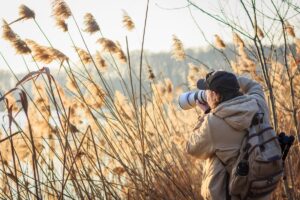In our ever more urbanized world, wildlife photography provides a captivating glimpse into the natural splendor that envelops us. Whether you’re an aspiring shutterbug or an experienced pro, below are some invaluable pointers to assist you in capturing breathtaking wildlife photographs that authentically encapsulate the essence of the untamed.
Research and Location
Before embarking on a wildlife photography journey, individuals must prioritize thorough research. It is crucial to acquire knowledge about the species they desire to capture through their lenses. This includes understanding their habits, habitats, and behavioral patterns. With this valuable insight, photographers can anticipate movements and greatly enhance their chances of capturing captivating shots.
Choosing the right location holds equal importance. National parks, wildlife reserves, and natural habitats brim with a wide array of species. It is crucial to conduct research on the optimum time to visit these areas as it can greatly impact the quality of your photographs. Animals tend to be more active during specific periods such as dawn and dusk, so planning your shoots accordingly will yield better results.
Patience and Observation
Capturing wildlife through photography requires immense patience. These fascinating creatures are often elusive, making it necessary to wait patiently for hours, or even days, to achieve the perfect shot. Once a suitable location is found, one must settle in and carefully observe the animals from a respectful distance. Utilizing binoculars not only allows us to avoid disturbing the but also aids in identifying captivating behaviors.
As the observer, one should make note of any recurring patterns or routines exhibited by the animals. Such observations prove instrumental in anticipating their movements and selecting the perfect moment to capture an image by pressing the shutter button. The key to capturing those elusive and genuine moments lies in exercising patience and careful observation.
Know Your Gear
Understanding the camera and equipment is vital for successful wildlife photography. Whether using a smartphone or a professional DSLR, it is important to invest time in familiarizing oneself with the camera’s settings, focusing modes, and capabilities. Wildlife shots often require swift adjustments, so being well-acquainted with your gear facilitates quick reactions to changing situations.
Invest in a telephoto lens to capture distant subjects without disturbing them. A tripod can also be invaluable in providing stability for those long hours of waiting. Remember to pack spare batteries and memory cards, as wildlife encounters are often unpredictable and might last longer than expected.
Composition and Lighting
Composition is a vital aspect of wildlife photography. To capture captivating and dynamic images, apply the rule of thirds by framing your subject off-center. Moreover, it is essential to be mindful of the background, ensuring it does not divert attention from the main subject.
Lighting plays a crucial role in photography. The use of soft, diffused light during the golden hours around sunrise and sunset can infuse your photos with warmth and depth. Conversely, the harsh midday sun can cast unflattering shadows. To optimize the available light, try experimenting with different angles.

Respect and Ethical Considerations
Respecting wildlife and their habitats should always remain a top priority. It is crucial to maintain a safe distance from the animals so as not to cause stress or disrupt their natural behavior. Consider using long lenses in order to observe them without intrusion into their personal space.
Moreover, one should always uphold ethical practices while capturing wildlife in photographs. It is essential to refrain from actions such as feeding, baiting, or intentionally disturbing animals solely for the purpose of obtaining a desired shot. The primary objective should revolve around observing and photographing animals in their natural habitat without causing any interference.
Engaging in wildlife photography offers numerous rewards as it allows individuals to form deep connections with the natural world. This enriching endeavor demands a combination of research, patience, technical skills, and genuine affection for the subjects being captured. By adhering to these suggestions and approaching encounters with unwavering respect for these magnificent creatures, one can produce captivating wildlife photos that weave tales and inspire profound appreciation for the beauty found in untamed landscapes.